Historiography Essay: The Idea of the Muslim World - A Global History
VerifiedAdded on 2023/04/21
|13
|3979
|443
Essay
AI Summary
This essay provides a historiographical analysis of Cemil Aydin's book, "The Idea of the Muslim World: A Global Intellectual History," focusing on the genealogy of notions surrounding the Muslim world and its evolution through the 19th and 20th centuries. It evaluates Aydin's thesis that the idea of a unified Muslim world is intertwined with assertions of Muslim contest and shaped significantly by European imperialism and responses from the Muslim community. The essay discusses various perspectives on Aydin's arguments, including the role of Western colonialism, internal conflicts within the Muslim community, and the historical context of pan-Islamism. It also addresses critiques of Aydin's selective focus and potential disregard for earlier historical dynamics, while acknowledging the significance of his narrative in understanding contemporary perceptions of Islamic identity and geopolitics.
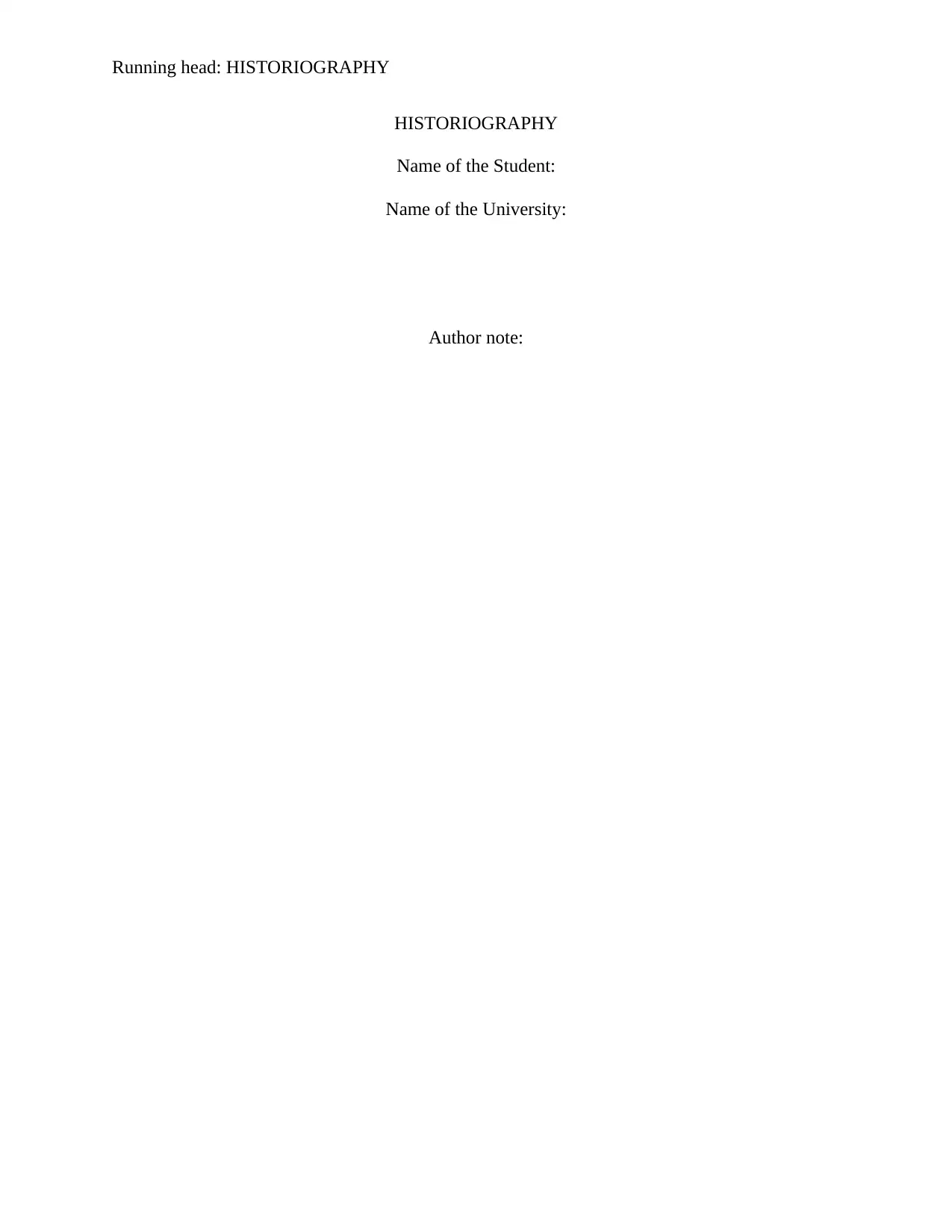
Running head: HISTORIOGRAPHY
HISTORIOGRAPHY
Name of the Student:
Name of the University:
Author note:
HISTORIOGRAPHY
Name of the Student:
Name of the University:
Author note:
Paraphrase This Document
Need a fresh take? Get an instant paraphrase of this document with our AI Paraphraser
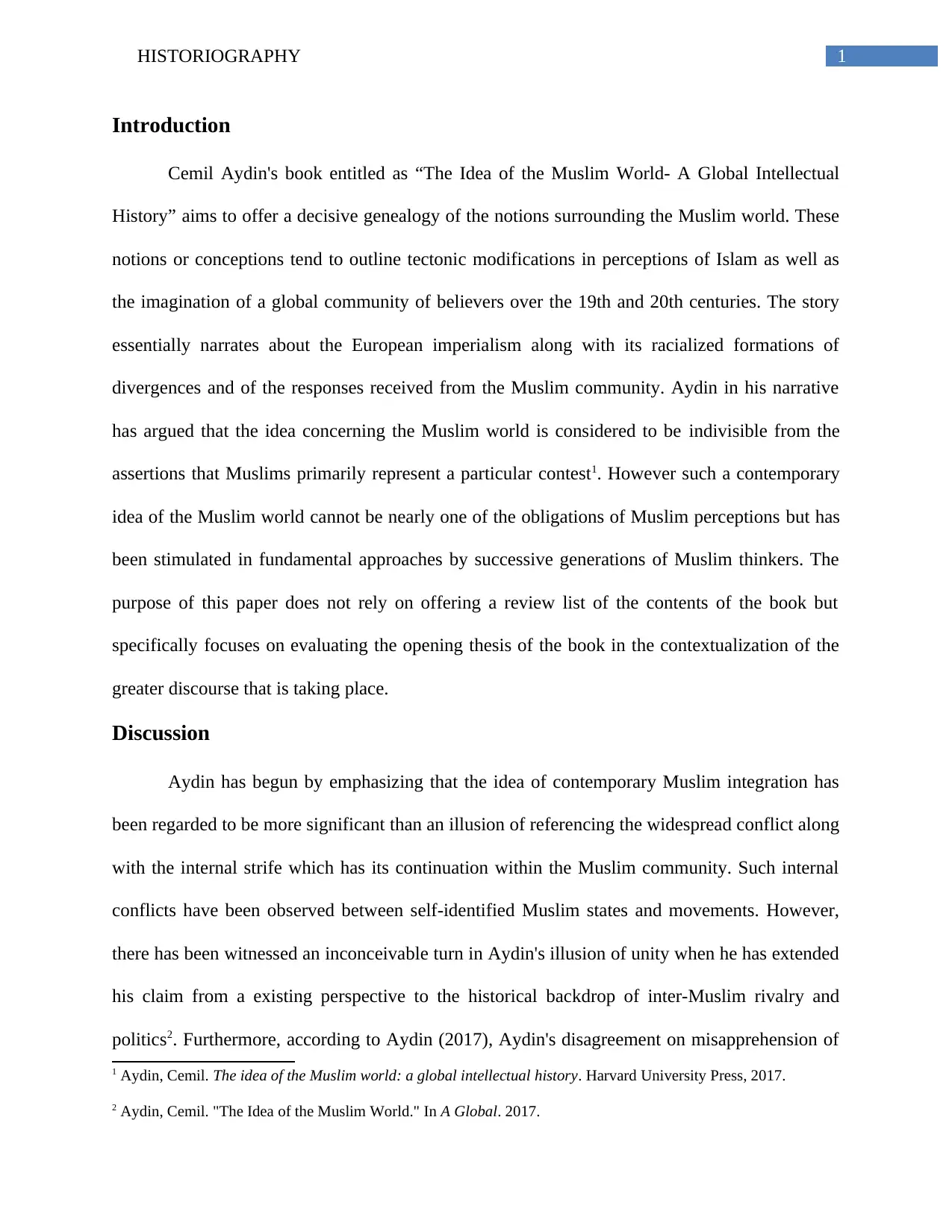
1HISTORIOGRAPHY
Introduction
Cemil Aydin's book entitled as “The Idea of the Muslim World- A Global Intellectual
History” aims to offer a decisive genealogy of the notions surrounding the Muslim world. These
notions or conceptions tend to outline tectonic modifications in perceptions of Islam as well as
the imagination of a global community of believers over the 19th and 20th centuries. The story
essentially narrates about the European imperialism along with its racialized formations of
divergences and of the responses received from the Muslim community. Aydin in his narrative
has argued that the idea concerning the Muslim world is considered to be indivisible from the
assertions that Muslims primarily represent a particular contest1. However such a contemporary
idea of the Muslim world cannot be nearly one of the obligations of Muslim perceptions but has
been stimulated in fundamental approaches by successive generations of Muslim thinkers. The
purpose of this paper does not rely on offering a review list of the contents of the book but
specifically focuses on evaluating the opening thesis of the book in the contextualization of the
greater discourse that is taking place.
Discussion
Aydin has begun by emphasizing that the idea of contemporary Muslim integration has
been regarded to be more significant than an illusion of referencing the widespread conflict along
with the internal strife which has its continuation within the Muslim community. Such internal
conflicts have been observed between self-identified Muslim states and movements. However,
there has been witnessed an inconceivable turn in Aydin's illusion of unity when he has extended
his claim from a existing perspective to the historical backdrop of inter-Muslim rivalry and
politics2. Furthermore, according to Aydin (2017), Aydin's disagreement on misapprehension of
1 Aydin, Cemil. The idea of the Muslim world: a global intellectual history. Harvard University Press, 2017.
2 Aydin, Cemil. "The Idea of the Muslim World." In A Global. 2017.
Introduction
Cemil Aydin's book entitled as “The Idea of the Muslim World- A Global Intellectual
History” aims to offer a decisive genealogy of the notions surrounding the Muslim world. These
notions or conceptions tend to outline tectonic modifications in perceptions of Islam as well as
the imagination of a global community of believers over the 19th and 20th centuries. The story
essentially narrates about the European imperialism along with its racialized formations of
divergences and of the responses received from the Muslim community. Aydin in his narrative
has argued that the idea concerning the Muslim world is considered to be indivisible from the
assertions that Muslims primarily represent a particular contest1. However such a contemporary
idea of the Muslim world cannot be nearly one of the obligations of Muslim perceptions but has
been stimulated in fundamental approaches by successive generations of Muslim thinkers. The
purpose of this paper does not rely on offering a review list of the contents of the book but
specifically focuses on evaluating the opening thesis of the book in the contextualization of the
greater discourse that is taking place.
Discussion
Aydin has begun by emphasizing that the idea of contemporary Muslim integration has
been regarded to be more significant than an illusion of referencing the widespread conflict along
with the internal strife which has its continuation within the Muslim community. Such internal
conflicts have been observed between self-identified Muslim states and movements. However,
there has been witnessed an inconceivable turn in Aydin's illusion of unity when he has extended
his claim from a existing perspective to the historical backdrop of inter-Muslim rivalry and
politics2. Furthermore, according to Aydin (2017), Aydin's disagreement on misapprehension of
1 Aydin, Cemil. The idea of the Muslim world: a global intellectual history. Harvard University Press, 2017.
2 Aydin, Cemil. "The Idea of the Muslim World." In A Global. 2017.
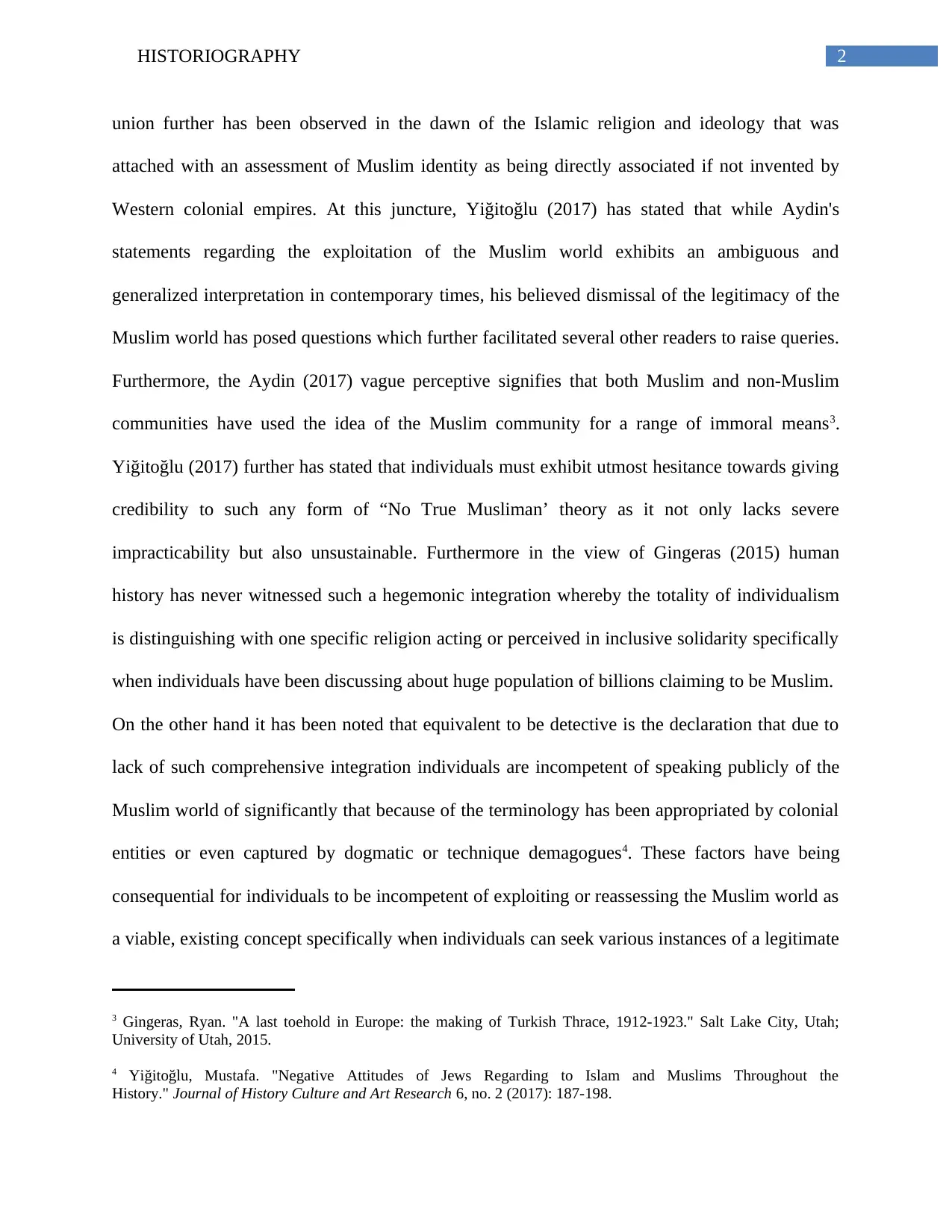
2HISTORIOGRAPHY
union further has been observed in the dawn of the Islamic religion and ideology that was
attached with an assessment of Muslim identity as being directly associated if not invented by
Western colonial empires. At this juncture, Yiğitoğlu (2017) has stated that while Aydin's
statements regarding the exploitation of the Muslim world exhibits an ambiguous and
generalized interpretation in contemporary times, his believed dismissal of the legitimacy of the
Muslim world has posed questions which further facilitated several other readers to raise queries.
Furthermore, the Aydin (2017) vague perceptive signifies that both Muslim and non-Muslim
communities have used the idea of the Muslim community for a range of immoral means3.
Yiğitoğlu (2017) further has stated that individuals must exhibit utmost hesitance towards giving
credibility to such any form of “No True Musliman’ theory as it not only lacks severe
impracticability but also unsustainable. Furthermore in the view of Gingeras (2015) human
history has never witnessed such a hegemonic integration whereby the totality of individualism
is distinguishing with one specific religion acting or perceived in inclusive solidarity specifically
when individuals have been discussing about huge population of billions claiming to be Muslim.
On the other hand it has been noted that equivalent to be detective is the declaration that due to
lack of such comprehensive integration individuals are incompetent of speaking publicly of the
Muslim world of significantly that because of the terminology has been appropriated by colonial
entities or even captured by dogmatic or technique demagogues4. These factors have being
consequential for individuals to be incompetent of exploiting or reassessing the Muslim world as
a viable, existing concept specifically when individuals can seek various instances of a legitimate
3 Gingeras, Ryan. "A last toehold in Europe: the making of Turkish Thrace, 1912-1923." Salt Lake City, Utah;
University of Utah, 2015.
4 Yiğitoğlu, Mustafa. "Negative Attitudes of Jews Regarding to Islam and Muslims Throughout the
History." Journal of History Culture and Art Research 6, no. 2 (2017): 187-198.
union further has been observed in the dawn of the Islamic religion and ideology that was
attached with an assessment of Muslim identity as being directly associated if not invented by
Western colonial empires. At this juncture, Yiğitoğlu (2017) has stated that while Aydin's
statements regarding the exploitation of the Muslim world exhibits an ambiguous and
generalized interpretation in contemporary times, his believed dismissal of the legitimacy of the
Muslim world has posed questions which further facilitated several other readers to raise queries.
Furthermore, the Aydin (2017) vague perceptive signifies that both Muslim and non-Muslim
communities have used the idea of the Muslim community for a range of immoral means3.
Yiğitoğlu (2017) further has stated that individuals must exhibit utmost hesitance towards giving
credibility to such any form of “No True Musliman’ theory as it not only lacks severe
impracticability but also unsustainable. Furthermore in the view of Gingeras (2015) human
history has never witnessed such a hegemonic integration whereby the totality of individualism
is distinguishing with one specific religion acting or perceived in inclusive solidarity specifically
when individuals have been discussing about huge population of billions claiming to be Muslim.
On the other hand it has been noted that equivalent to be detective is the declaration that due to
lack of such comprehensive integration individuals are incompetent of speaking publicly of the
Muslim world of significantly that because of the terminology has been appropriated by colonial
entities or even captured by dogmatic or technique demagogues4. These factors have being
consequential for individuals to be incompetent of exploiting or reassessing the Muslim world as
a viable, existing concept specifically when individuals can seek various instances of a legitimate
3 Gingeras, Ryan. "A last toehold in Europe: the making of Turkish Thrace, 1912-1923." Salt Lake City, Utah;
University of Utah, 2015.
4 Yiğitoğlu, Mustafa. "Negative Attitudes of Jews Regarding to Islam and Muslims Throughout the
History." Journal of History Culture and Art Research 6, no. 2 (2017): 187-198.
⊘ This is a preview!⊘
Do you want full access?
Subscribe today to unlock all pages.

Trusted by 1+ million students worldwide
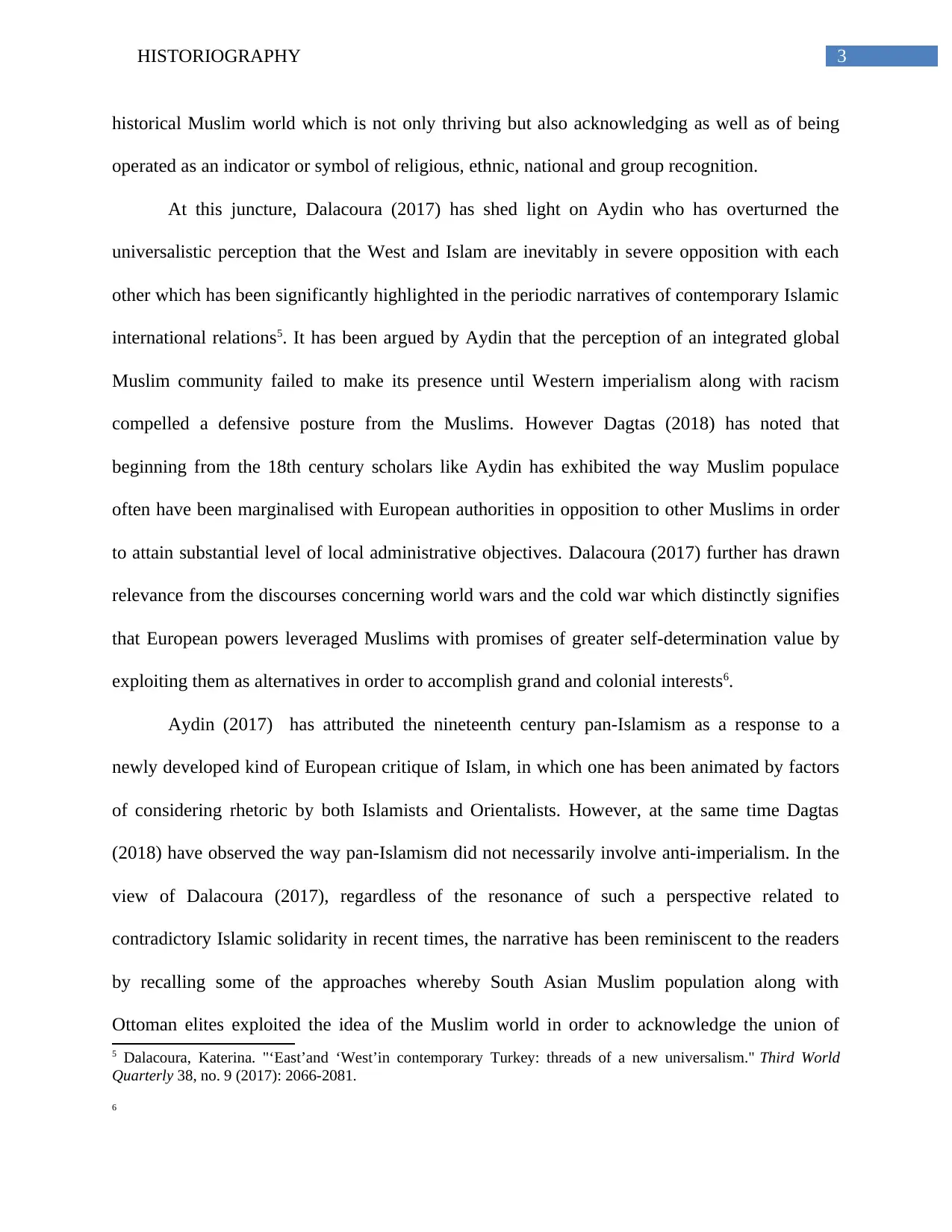
3HISTORIOGRAPHY
historical Muslim world which is not only thriving but also acknowledging as well as of being
operated as an indicator or symbol of religious, ethnic, national and group recognition.
At this juncture, Dalacoura (2017) has shed light on Aydin who has overturned the
universalistic perception that the West and Islam are inevitably in severe opposition with each
other which has been significantly highlighted in the periodic narratives of contemporary Islamic
international relations5. It has been argued by Aydin that the perception of an integrated global
Muslim community failed to make its presence until Western imperialism along with racism
compelled a defensive posture from the Muslims. However Dagtas (2018) has noted that
beginning from the 18th century scholars like Aydin has exhibited the way Muslim populace
often have been marginalised with European authorities in opposition to other Muslims in order
to attain substantial level of local administrative objectives. Dalacoura (2017) further has drawn
relevance from the discourses concerning world wars and the cold war which distinctly signifies
that European powers leveraged Muslims with promises of greater self-determination value by
exploiting them as alternatives in order to accomplish grand and colonial interests6.
Aydin (2017) has attributed the nineteenth century pan-Islamism as a response to a
newly developed kind of European critique of Islam, in which one has been animated by factors
of considering rhetoric by both Islamists and Orientalists. However, at the same time Dagtas
(2018) have observed the way pan-Islamism did not necessarily involve anti-imperialism. In the
view of Dalacoura (2017), regardless of the resonance of such a perspective related to
contradictory Islamic solidarity in recent times, the narrative has been reminiscent to the readers
by recalling some of the approaches whereby South Asian Muslim population along with
Ottoman elites exploited the idea of the Muslim world in order to acknowledge the union of
5 Dalacoura, Katerina. "‘East’and ‘West’in contemporary Turkey: threads of a new universalism." Third World
Quarterly 38, no. 9 (2017): 2066-2081.
6
historical Muslim world which is not only thriving but also acknowledging as well as of being
operated as an indicator or symbol of religious, ethnic, national and group recognition.
At this juncture, Dalacoura (2017) has shed light on Aydin who has overturned the
universalistic perception that the West and Islam are inevitably in severe opposition with each
other which has been significantly highlighted in the periodic narratives of contemporary Islamic
international relations5. It has been argued by Aydin that the perception of an integrated global
Muslim community failed to make its presence until Western imperialism along with racism
compelled a defensive posture from the Muslims. However Dagtas (2018) has noted that
beginning from the 18th century scholars like Aydin has exhibited the way Muslim populace
often have been marginalised with European authorities in opposition to other Muslims in order
to attain substantial level of local administrative objectives. Dalacoura (2017) further has drawn
relevance from the discourses concerning world wars and the cold war which distinctly signifies
that European powers leveraged Muslims with promises of greater self-determination value by
exploiting them as alternatives in order to accomplish grand and colonial interests6.
Aydin (2017) has attributed the nineteenth century pan-Islamism as a response to a
newly developed kind of European critique of Islam, in which one has been animated by factors
of considering rhetoric by both Islamists and Orientalists. However, at the same time Dagtas
(2018) have observed the way pan-Islamism did not necessarily involve anti-imperialism. In the
view of Dalacoura (2017), regardless of the resonance of such a perspective related to
contradictory Islamic solidarity in recent times, the narrative has been reminiscent to the readers
by recalling some of the approaches whereby South Asian Muslim population along with
Ottoman elites exploited the idea of the Muslim world in order to acknowledge the union of
5 Dalacoura, Katerina. "‘East’and ‘West’in contemporary Turkey: threads of a new universalism." Third World
Quarterly 38, no. 9 (2017): 2066-2081.
6
Paraphrase This Document
Need a fresh take? Get an instant paraphrase of this document with our AI Paraphraser

4HISTORIOGRAPHY
Ottoman-British alliance7. Aydin as a consequence successfully recounts a history of the
instabilities of the appeal related to the pan-Islamism through the extended twentieth century. In
addition to this, Gurbanveliyev (2016) while reviewing the book of Aydin has observed a distinct
as well as ardent narrative makes a significant intervention into contemporary discussion,
historicizing the considerably recent elevation of the pervasive discussions on Islamic religious
perceptions in contemporary geo-politics8. Historians of pre-modern periods, in such a standpoint
tend to pose queries regarding the claims which state that the idea of the Muslim world began to
emerge in the nineteenth century. At this juncture, Ahmed (2015 ) has posed assertions in his
posthumous magnum opuses What is Islam?” while supporting the substantiation of a
widespread cosmopolitanism in pre-modern imperial modes of governance that it would be
highly unfeasible to exaggerate the meaningfulness of the experience concerning the notion of
the common community of Islam or further of Islam as universal community in the
conceptualization of Islam9.
Meanwhile Chen (2014) has claimed that while it is distinct that the newly developed
dynamics in the creation of contemporary political conceptualizations have essentially
considered imaginations of Muslim integration over the nineteenth and twentieth century.
However, in navigating such an intelligent corrective course, Aydin’s focus has selectively
disregarded the impediments of earlier historical eras. For instances, the ideas of the narrative
has claimed that the fourteenth century North African traveller did not have the concept of an
intimidating, alien and evolution. Furthermore, for the perception of Ibn Battuta there has been
7 Dagtas, Banu. "Contested Modernities:‘Diverse Voices’of The Pioneering Journalists In The Ottoman
Empire." Journal of Media Critiques [JMC] 3, no. 12 (2018).
8 Gurbanveliyev, Bayramdurdy. "Fethullah Gulen's Concept of Knowledge in Context on the Contemporary Muslim
Reformist Thought." PhD diss., Universiti Teknologi Malaysia, 2016.
9 Ahmed, Shahab. What is Islam?: The importance of being Islamic. Princeton University Press, 2015.
Ottoman-British alliance7. Aydin as a consequence successfully recounts a history of the
instabilities of the appeal related to the pan-Islamism through the extended twentieth century. In
addition to this, Gurbanveliyev (2016) while reviewing the book of Aydin has observed a distinct
as well as ardent narrative makes a significant intervention into contemporary discussion,
historicizing the considerably recent elevation of the pervasive discussions on Islamic religious
perceptions in contemporary geo-politics8. Historians of pre-modern periods, in such a standpoint
tend to pose queries regarding the claims which state that the idea of the Muslim world began to
emerge in the nineteenth century. At this juncture, Ahmed (2015 ) has posed assertions in his
posthumous magnum opuses What is Islam?” while supporting the substantiation of a
widespread cosmopolitanism in pre-modern imperial modes of governance that it would be
highly unfeasible to exaggerate the meaningfulness of the experience concerning the notion of
the common community of Islam or further of Islam as universal community in the
conceptualization of Islam9.
Meanwhile Chen (2014) has claimed that while it is distinct that the newly developed
dynamics in the creation of contemporary political conceptualizations have essentially
considered imaginations of Muslim integration over the nineteenth and twentieth century.
However, in navigating such an intelligent corrective course, Aydin’s focus has selectively
disregarded the impediments of earlier historical eras. For instances, the ideas of the narrative
has claimed that the fourteenth century North African traveller did not have the concept of an
intimidating, alien and evolution. Furthermore, for the perception of Ibn Battuta there has been
7 Dagtas, Banu. "Contested Modernities:‘Diverse Voices’of The Pioneering Journalists In The Ottoman
Empire." Journal of Media Critiques [JMC] 3, no. 12 (2018).
8 Gurbanveliyev, Bayramdurdy. "Fethullah Gulen's Concept of Knowledge in Context on the Contemporary Muslim
Reformist Thought." PhD diss., Universiti Teknologi Malaysia, 2016.
9 Ahmed, Shahab. What is Islam?: The importance of being Islamic. Princeton University Press, 2015.
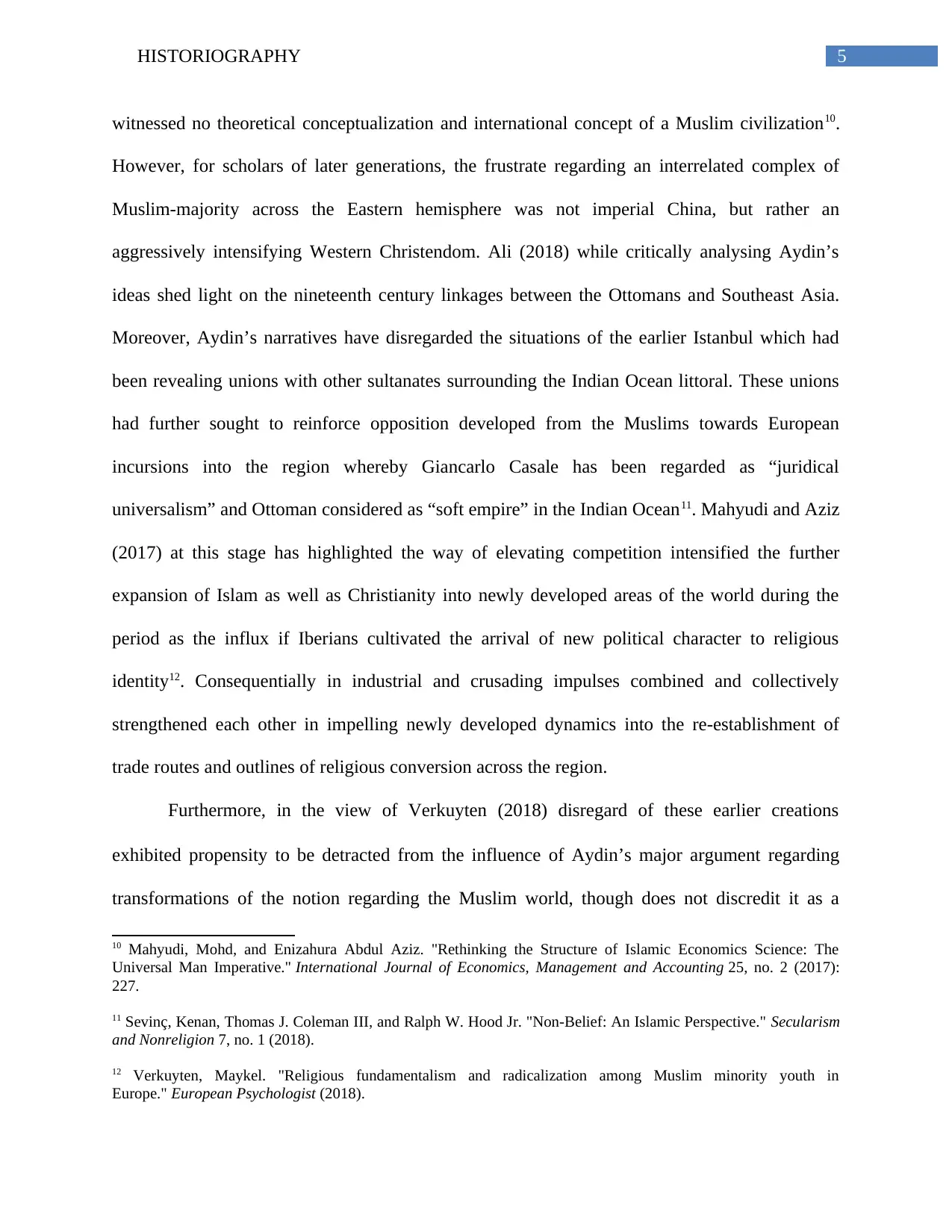
5HISTORIOGRAPHY
witnessed no theoretical conceptualization and international concept of a Muslim civilization10.
However, for scholars of later generations, the frustrate regarding an interrelated complex of
Muslim-majority across the Eastern hemisphere was not imperial China, but rather an
aggressively intensifying Western Christendom. Ali (2018) while critically analysing Aydin’s
ideas shed light on the nineteenth century linkages between the Ottomans and Southeast Asia.
Moreover, Aydin’s narratives have disregarded the situations of the earlier Istanbul which had
been revealing unions with other sultanates surrounding the Indian Ocean littoral. These unions
had further sought to reinforce opposition developed from the Muslims towards European
incursions into the region whereby Giancarlo Casale has been regarded as “juridical
universalism” and Ottoman considered as “soft empire” in the Indian Ocean11. Mahyudi and Aziz
(2017) at this stage has highlighted the way of elevating competition intensified the further
expansion of Islam as well as Christianity into newly developed areas of the world during the
period as the influx if Iberians cultivated the arrival of new political character to religious
identity12. Consequentially in industrial and crusading impulses combined and collectively
strengthened each other in impelling newly developed dynamics into the re-establishment of
trade routes and outlines of religious conversion across the region.
Furthermore, in the view of Verkuyten (2018) disregard of these earlier creations
exhibited propensity to be detracted from the influence of Aydin’s major argument regarding
transformations of the notion regarding the Muslim world, though does not discredit it as a
10 Mahyudi, Mohd, and Enizahura Abdul Aziz. "Rethinking the Structure of Islamic Economics Science: The
Universal Man Imperative." International Journal of Economics, Management and Accounting 25, no. 2 (2017):
227.
11 Sevinç, Kenan, Thomas J. Coleman III, and Ralph W. Hood Jr. "Non-Belief: An Islamic Perspective." Secularism
and Nonreligion 7, no. 1 (2018).
12 Verkuyten, Maykel. "Religious fundamentalism and radicalization among Muslim minority youth in
Europe." European Psychologist (2018).
witnessed no theoretical conceptualization and international concept of a Muslim civilization10.
However, for scholars of later generations, the frustrate regarding an interrelated complex of
Muslim-majority across the Eastern hemisphere was not imperial China, but rather an
aggressively intensifying Western Christendom. Ali (2018) while critically analysing Aydin’s
ideas shed light on the nineteenth century linkages between the Ottomans and Southeast Asia.
Moreover, Aydin’s narratives have disregarded the situations of the earlier Istanbul which had
been revealing unions with other sultanates surrounding the Indian Ocean littoral. These unions
had further sought to reinforce opposition developed from the Muslims towards European
incursions into the region whereby Giancarlo Casale has been regarded as “juridical
universalism” and Ottoman considered as “soft empire” in the Indian Ocean11. Mahyudi and Aziz
(2017) at this stage has highlighted the way of elevating competition intensified the further
expansion of Islam as well as Christianity into newly developed areas of the world during the
period as the influx if Iberians cultivated the arrival of new political character to religious
identity12. Consequentially in industrial and crusading impulses combined and collectively
strengthened each other in impelling newly developed dynamics into the re-establishment of
trade routes and outlines of religious conversion across the region.
Furthermore, in the view of Verkuyten (2018) disregard of these earlier creations
exhibited propensity to be detracted from the influence of Aydin’s major argument regarding
transformations of the notion regarding the Muslim world, though does not discredit it as a
10 Mahyudi, Mohd, and Enizahura Abdul Aziz. "Rethinking the Structure of Islamic Economics Science: The
Universal Man Imperative." International Journal of Economics, Management and Accounting 25, no. 2 (2017):
227.
11 Sevinç, Kenan, Thomas J. Coleman III, and Ralph W. Hood Jr. "Non-Belief: An Islamic Perspective." Secularism
and Nonreligion 7, no. 1 (2018).
12 Verkuyten, Maykel. "Religious fundamentalism and radicalization among Muslim minority youth in
Europe." European Psychologist (2018).
⊘ This is a preview!⊘
Do you want full access?
Subscribe today to unlock all pages.

Trusted by 1+ million students worldwide
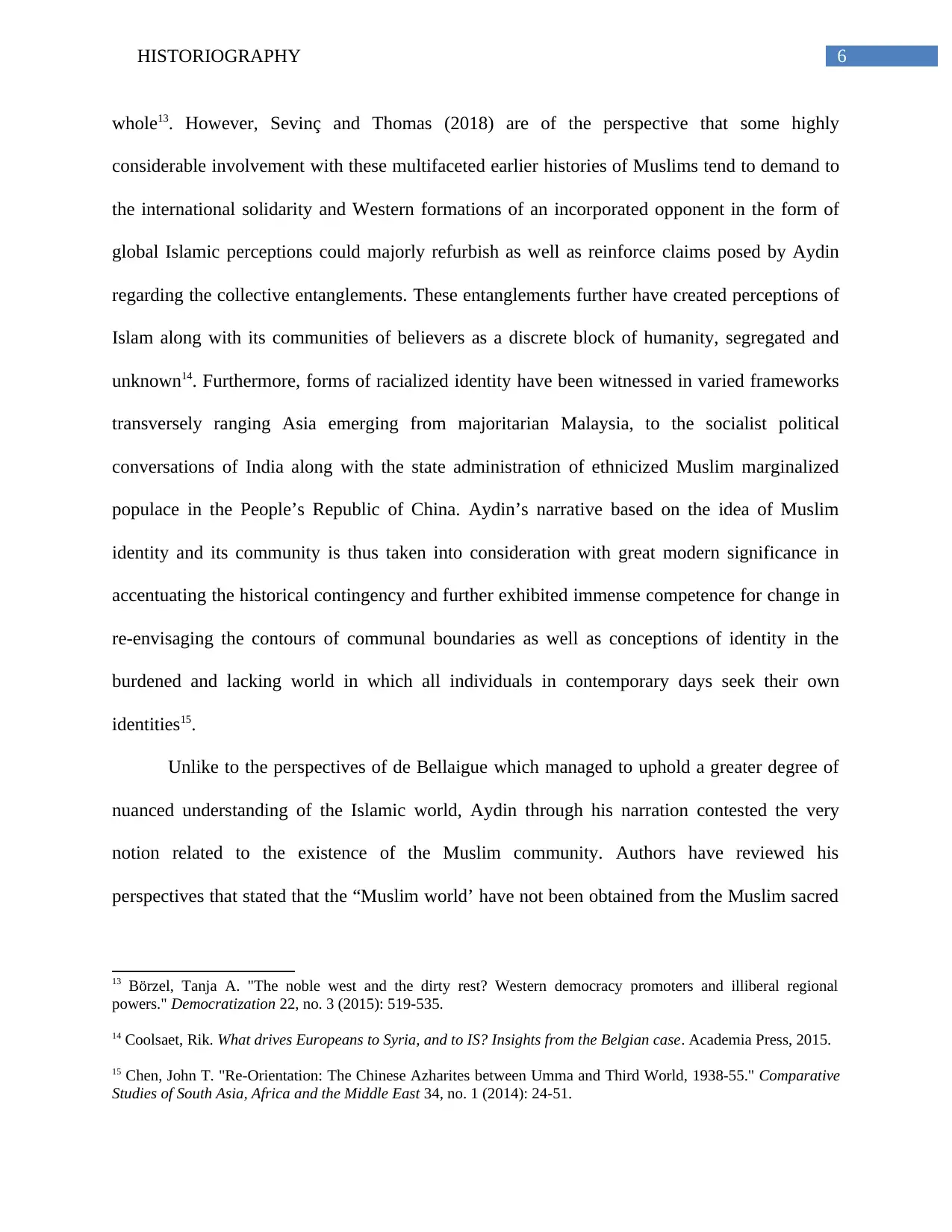
6HISTORIOGRAPHY
whole13. However, Sevinç and Thomas (2018) are of the perspective that some highly
considerable involvement with these multifaceted earlier histories of Muslims tend to demand to
the international solidarity and Western formations of an incorporated opponent in the form of
global Islamic perceptions could majorly refurbish as well as reinforce claims posed by Aydin
regarding the collective entanglements. These entanglements further have created perceptions of
Islam along with its communities of believers as a discrete block of humanity, segregated and
unknown14. Furthermore, forms of racialized identity have been witnessed in varied frameworks
transversely ranging Asia emerging from majoritarian Malaysia, to the socialist political
conversations of India along with the state administration of ethnicized Muslim marginalized
populace in the People’s Republic of China. Aydin’s narrative based on the idea of Muslim
identity and its community is thus taken into consideration with great modern significance in
accentuating the historical contingency and further exhibited immense competence for change in
re-envisaging the contours of communal boundaries as well as conceptions of identity in the
burdened and lacking world in which all individuals in contemporary days seek their own
identities15.
Unlike to the perspectives of de Bellaigue which managed to uphold a greater degree of
nuanced understanding of the Islamic world, Aydin through his narration contested the very
notion related to the existence of the Muslim community. Authors have reviewed his
perspectives that stated that the “Muslim world’ have not been obtained from the Muslim sacred
13 Börzel, Tanja A. "The noble west and the dirty rest? Western democracy promoters and illiberal regional
powers." Democratization 22, no. 3 (2015): 519-535.
14 Coolsaet, Rik. What drives Europeans to Syria, and to IS? Insights from the Belgian case. Academia Press, 2015.
15 Chen, John T. "Re-Orientation: The Chinese Azharites between Umma and Third World, 1938-55." Comparative
Studies of South Asia, Africa and the Middle East 34, no. 1 (2014): 24-51.
whole13. However, Sevinç and Thomas (2018) are of the perspective that some highly
considerable involvement with these multifaceted earlier histories of Muslims tend to demand to
the international solidarity and Western formations of an incorporated opponent in the form of
global Islamic perceptions could majorly refurbish as well as reinforce claims posed by Aydin
regarding the collective entanglements. These entanglements further have created perceptions of
Islam along with its communities of believers as a discrete block of humanity, segregated and
unknown14. Furthermore, forms of racialized identity have been witnessed in varied frameworks
transversely ranging Asia emerging from majoritarian Malaysia, to the socialist political
conversations of India along with the state administration of ethnicized Muslim marginalized
populace in the People’s Republic of China. Aydin’s narrative based on the idea of Muslim
identity and its community is thus taken into consideration with great modern significance in
accentuating the historical contingency and further exhibited immense competence for change in
re-envisaging the contours of communal boundaries as well as conceptions of identity in the
burdened and lacking world in which all individuals in contemporary days seek their own
identities15.
Unlike to the perspectives of de Bellaigue which managed to uphold a greater degree of
nuanced understanding of the Islamic world, Aydin through his narration contested the very
notion related to the existence of the Muslim community. Authors have reviewed his
perspectives that stated that the “Muslim world’ have not been obtained from the Muslim sacred
13 Börzel, Tanja A. "The noble west and the dirty rest? Western democracy promoters and illiberal regional
powers." Democratization 22, no. 3 (2015): 519-535.
14 Coolsaet, Rik. What drives Europeans to Syria, and to IS? Insights from the Belgian case. Academia Press, 2015.
15 Chen, John T. "Re-Orientation: The Chinese Azharites between Umma and Third World, 1938-55." Comparative
Studies of South Asia, Africa and the Middle East 34, no. 1 (2014): 24-51.
Paraphrase This Document
Need a fresh take? Get an instant paraphrase of this document with our AI Paraphraser
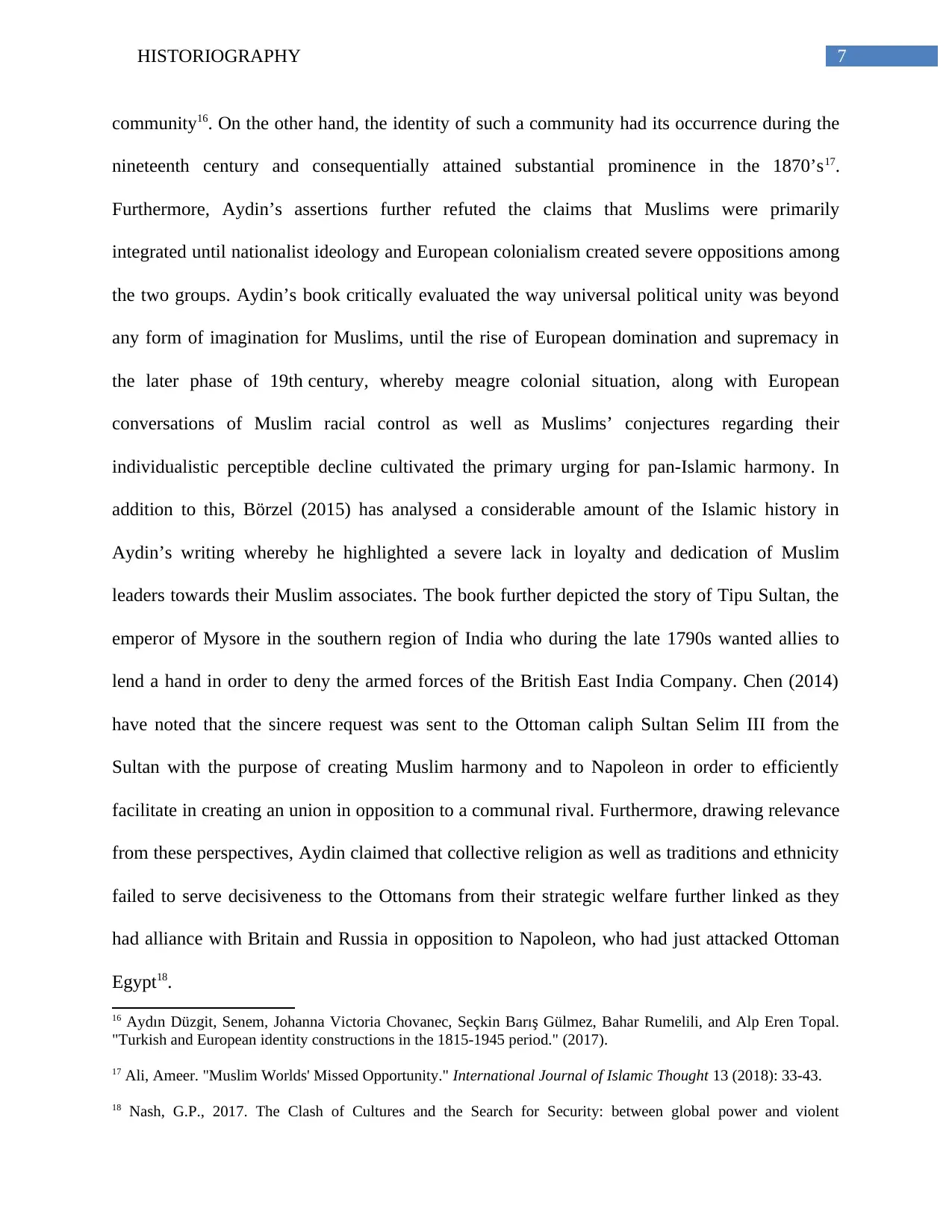
7HISTORIOGRAPHY
community16. On the other hand, the identity of such a community had its occurrence during the
nineteenth century and consequentially attained substantial prominence in the 1870’s17.
Furthermore, Aydin’s assertions further refuted the claims that Muslims were primarily
integrated until nationalist ideology and European colonialism created severe oppositions among
the two groups. Aydin’s book critically evaluated the way universal political unity was beyond
any form of imagination for Muslims, until the rise of European domination and supremacy in
the later phase of 19th century, whereby meagre colonial situation, along with European
conversations of Muslim racial control as well as Muslims’ conjectures regarding their
individualistic perceptible decline cultivated the primary urging for pan-Islamic harmony. In
addition to this, Börzel (2015) has analysed a considerable amount of the Islamic history in
Aydin’s writing whereby he highlighted a severe lack in loyalty and dedication of Muslim
leaders towards their Muslim associates. The book further depicted the story of Tipu Sultan, the
emperor of Mysore in the southern region of India who during the late 1790s wanted allies to
lend a hand in order to deny the armed forces of the British East India Company. Chen (2014)
have noted that the sincere request was sent to the Ottoman caliph Sultan Selim III from the
Sultan with the purpose of creating Muslim harmony and to Napoleon in order to efficiently
facilitate in creating an union in opposition to a communal rival. Furthermore, drawing relevance
from these perspectives, Aydin claimed that collective religion as well as traditions and ethnicity
failed to serve decisiveness to the Ottomans from their strategic welfare further linked as they
had alliance with Britain and Russia in opposition to Napoleon, who had just attacked Ottoman
Egypt18.
16 Aydın Düzgit, Senem, Johanna Victoria Chovanec, Seçkin Barış Gülmez, Bahar Rumelili, and Alp Eren Topal.
"Turkish and European identity constructions in the 1815-1945 period." (2017).
17 Ali, Ameer. "Muslim Worlds' Missed Opportunity." International Journal of Islamic Thought 13 (2018): 33-43.
18 Nash, G.P., 2017. The Clash of Cultures and the Search for Security: between global power and violent
community16. On the other hand, the identity of such a community had its occurrence during the
nineteenth century and consequentially attained substantial prominence in the 1870’s17.
Furthermore, Aydin’s assertions further refuted the claims that Muslims were primarily
integrated until nationalist ideology and European colonialism created severe oppositions among
the two groups. Aydin’s book critically evaluated the way universal political unity was beyond
any form of imagination for Muslims, until the rise of European domination and supremacy in
the later phase of 19th century, whereby meagre colonial situation, along with European
conversations of Muslim racial control as well as Muslims’ conjectures regarding their
individualistic perceptible decline cultivated the primary urging for pan-Islamic harmony. In
addition to this, Börzel (2015) has analysed a considerable amount of the Islamic history in
Aydin’s writing whereby he highlighted a severe lack in loyalty and dedication of Muslim
leaders towards their Muslim associates. The book further depicted the story of Tipu Sultan, the
emperor of Mysore in the southern region of India who during the late 1790s wanted allies to
lend a hand in order to deny the armed forces of the British East India Company. Chen (2014)
have noted that the sincere request was sent to the Ottoman caliph Sultan Selim III from the
Sultan with the purpose of creating Muslim harmony and to Napoleon in order to efficiently
facilitate in creating an union in opposition to a communal rival. Furthermore, drawing relevance
from these perspectives, Aydin claimed that collective religion as well as traditions and ethnicity
failed to serve decisiveness to the Ottomans from their strategic welfare further linked as they
had alliance with Britain and Russia in opposition to Napoleon, who had just attacked Ottoman
Egypt18.
16 Aydın Düzgit, Senem, Johanna Victoria Chovanec, Seçkin Barış Gülmez, Bahar Rumelili, and Alp Eren Topal.
"Turkish and European identity constructions in the 1815-1945 period." (2017).
17 Ali, Ameer. "Muslim Worlds' Missed Opportunity." International Journal of Islamic Thought 13 (2018): 33-43.
18 Nash, G.P., 2017. The Clash of Cultures and the Search for Security: between global power and violent
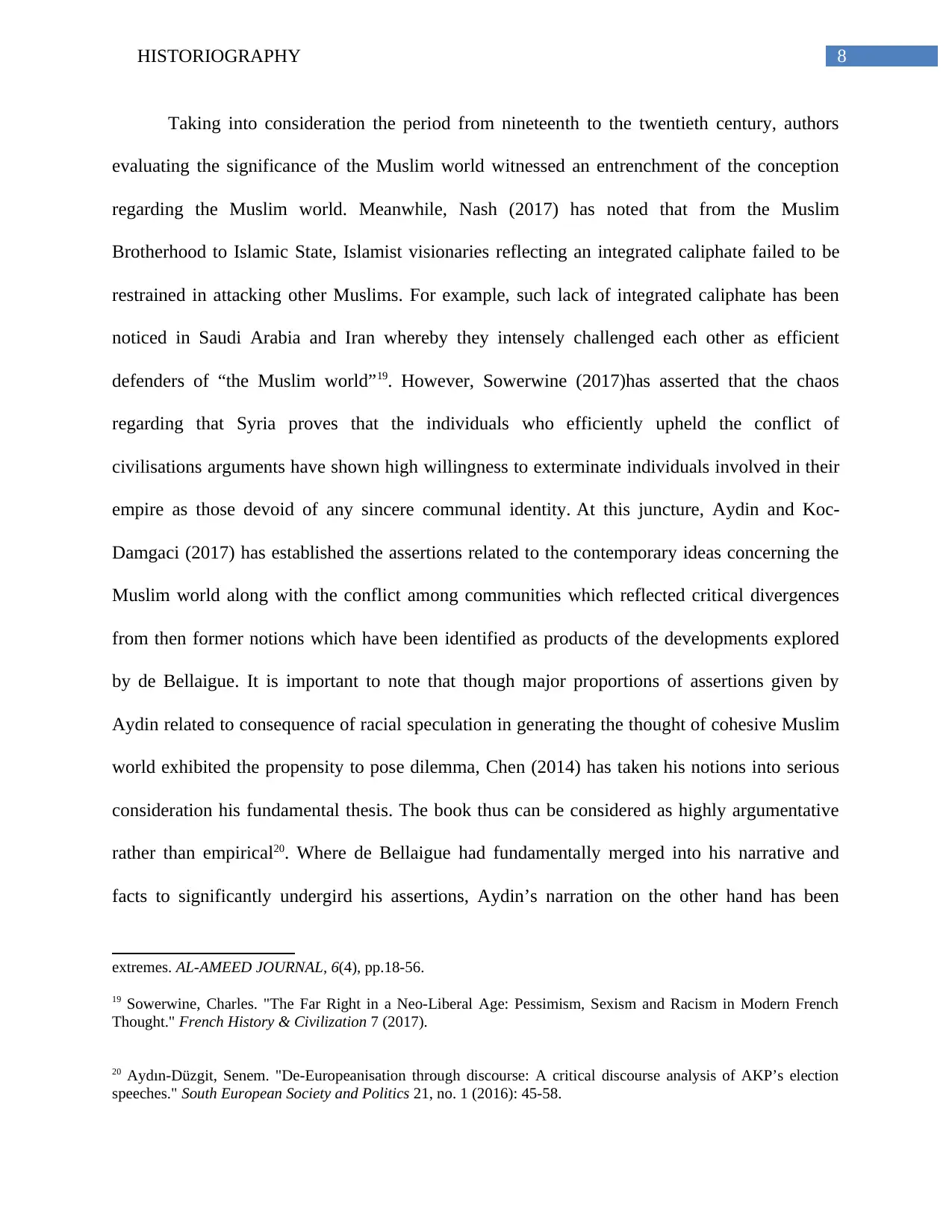
8HISTORIOGRAPHY
Taking into consideration the period from nineteenth to the twentieth century, authors
evaluating the significance of the Muslim world witnessed an entrenchment of the conception
regarding the Muslim world. Meanwhile, Nash (2017) has noted that from the Muslim
Brotherhood to Islamic State, Islamist visionaries reflecting an integrated caliphate failed to be
restrained in attacking other Muslims. For example, such lack of integrated caliphate has been
noticed in Saudi Arabia and Iran whereby they intensely challenged each other as efficient
defenders of “the Muslim world”19. However, Sowerwine (2017)has asserted that the chaos
regarding that Syria proves that the individuals who efficiently upheld the conflict of
civilisations arguments have shown high willingness to exterminate individuals involved in their
empire as those devoid of any sincere communal identity. At this juncture, Aydin and Koc-
Damgaci (2017) has established the assertions related to the contemporary ideas concerning the
Muslim world along with the conflict among communities which reflected critical divergences
from then former notions which have been identified as products of the developments explored
by de Bellaigue. It is important to note that though major proportions of assertions given by
Aydin related to consequence of racial speculation in generating the thought of cohesive Muslim
world exhibited the propensity to pose dilemma, Chen (2014) has taken his notions into serious
consideration his fundamental thesis. The book thus can be considered as highly argumentative
rather than empirical20. Where de Bellaigue had fundamentally merged into his narrative and
facts to significantly undergird his assertions, Aydin’s narration on the other hand has been
extremes. AL-AMEED JOURNAL, 6(4), pp.18-56.
19 Sowerwine, Charles. "The Far Right in a Neo-Liberal Age: Pessimism, Sexism and Racism in Modern French
Thought." French History & Civilization 7 (2017).
20 Aydın-Düzgit, Senem. "De-Europeanisation through discourse: A critical discourse analysis of AKP’s election
speeches." South European Society and Politics 21, no. 1 (2016): 45-58.
Taking into consideration the period from nineteenth to the twentieth century, authors
evaluating the significance of the Muslim world witnessed an entrenchment of the conception
regarding the Muslim world. Meanwhile, Nash (2017) has noted that from the Muslim
Brotherhood to Islamic State, Islamist visionaries reflecting an integrated caliphate failed to be
restrained in attacking other Muslims. For example, such lack of integrated caliphate has been
noticed in Saudi Arabia and Iran whereby they intensely challenged each other as efficient
defenders of “the Muslim world”19. However, Sowerwine (2017)has asserted that the chaos
regarding that Syria proves that the individuals who efficiently upheld the conflict of
civilisations arguments have shown high willingness to exterminate individuals involved in their
empire as those devoid of any sincere communal identity. At this juncture, Aydin and Koc-
Damgaci (2017) has established the assertions related to the contemporary ideas concerning the
Muslim world along with the conflict among communities which reflected critical divergences
from then former notions which have been identified as products of the developments explored
by de Bellaigue. It is important to note that though major proportions of assertions given by
Aydin related to consequence of racial speculation in generating the thought of cohesive Muslim
world exhibited the propensity to pose dilemma, Chen (2014) has taken his notions into serious
consideration his fundamental thesis. The book thus can be considered as highly argumentative
rather than empirical20. Where de Bellaigue had fundamentally merged into his narrative and
facts to significantly undergird his assertions, Aydin’s narration on the other hand has been
extremes. AL-AMEED JOURNAL, 6(4), pp.18-56.
19 Sowerwine, Charles. "The Far Right in a Neo-Liberal Age: Pessimism, Sexism and Racism in Modern French
Thought." French History & Civilization 7 (2017).
20 Aydın-Düzgit, Senem. "De-Europeanisation through discourse: A critical discourse analysis of AKP’s election
speeches." South European Society and Politics 21, no. 1 (2016): 45-58.
⊘ This is a preview!⊘
Do you want full access?
Subscribe today to unlock all pages.

Trusted by 1+ million students worldwide
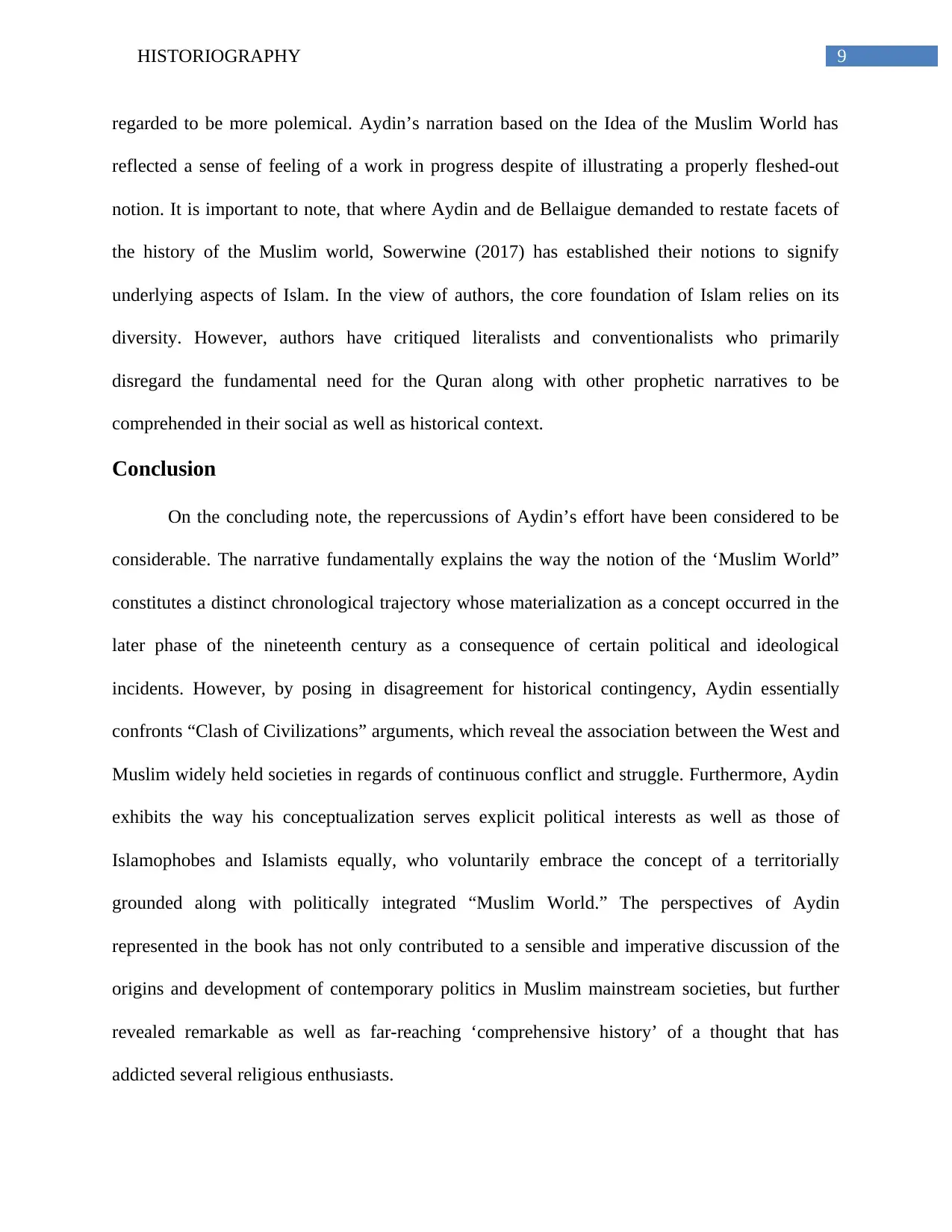
9HISTORIOGRAPHY
regarded to be more polemical. Aydin’s narration based on the Idea of the Muslim World has
reflected a sense of feeling of a work in progress despite of illustrating a properly fleshed-out
notion. It is important to note, that where Aydin and de Bellaigue demanded to restate facets of
the history of the Muslim world, Sowerwine (2017) has established their notions to signify
underlying aspects of Islam. In the view of authors, the core foundation of Islam relies on its
diversity. However, authors have critiqued literalists and conventionalists who primarily
disregard the fundamental need for the Quran along with other prophetic narratives to be
comprehended in their social as well as historical context.
Conclusion
On the concluding note, the repercussions of Aydin’s effort have been considered to be
considerable. The narrative fundamentally explains the way the notion of the ‘Muslim World”
constitutes a distinct chronological trajectory whose materialization as a concept occurred in the
later phase of the nineteenth century as a consequence of certain political and ideological
incidents. However, by posing in disagreement for historical contingency, Aydin essentially
confronts “Clash of Civilizations” arguments, which reveal the association between the West and
Muslim widely held societies in regards of continuous conflict and struggle. Furthermore, Aydin
exhibits the way his conceptualization serves explicit political interests as well as those of
Islamophobes and Islamists equally, who voluntarily embrace the concept of a territorially
grounded along with politically integrated “Muslim World.” The perspectives of Aydin
represented in the book has not only contributed to a sensible and imperative discussion of the
origins and development of contemporary politics in Muslim mainstream societies, but further
revealed remarkable as well as far-reaching ‘comprehensive history’ of a thought that has
addicted several religious enthusiasts.
regarded to be more polemical. Aydin’s narration based on the Idea of the Muslim World has
reflected a sense of feeling of a work in progress despite of illustrating a properly fleshed-out
notion. It is important to note, that where Aydin and de Bellaigue demanded to restate facets of
the history of the Muslim world, Sowerwine (2017) has established their notions to signify
underlying aspects of Islam. In the view of authors, the core foundation of Islam relies on its
diversity. However, authors have critiqued literalists and conventionalists who primarily
disregard the fundamental need for the Quran along with other prophetic narratives to be
comprehended in their social as well as historical context.
Conclusion
On the concluding note, the repercussions of Aydin’s effort have been considered to be
considerable. The narrative fundamentally explains the way the notion of the ‘Muslim World”
constitutes a distinct chronological trajectory whose materialization as a concept occurred in the
later phase of the nineteenth century as a consequence of certain political and ideological
incidents. However, by posing in disagreement for historical contingency, Aydin essentially
confronts “Clash of Civilizations” arguments, which reveal the association between the West and
Muslim widely held societies in regards of continuous conflict and struggle. Furthermore, Aydin
exhibits the way his conceptualization serves explicit political interests as well as those of
Islamophobes and Islamists equally, who voluntarily embrace the concept of a territorially
grounded along with politically integrated “Muslim World.” The perspectives of Aydin
represented in the book has not only contributed to a sensible and imperative discussion of the
origins and development of contemporary politics in Muslim mainstream societies, but further
revealed remarkable as well as far-reaching ‘comprehensive history’ of a thought that has
addicted several religious enthusiasts.
Paraphrase This Document
Need a fresh take? Get an instant paraphrase of this document with our AI Paraphraser

10HISTORIOGRAPHY
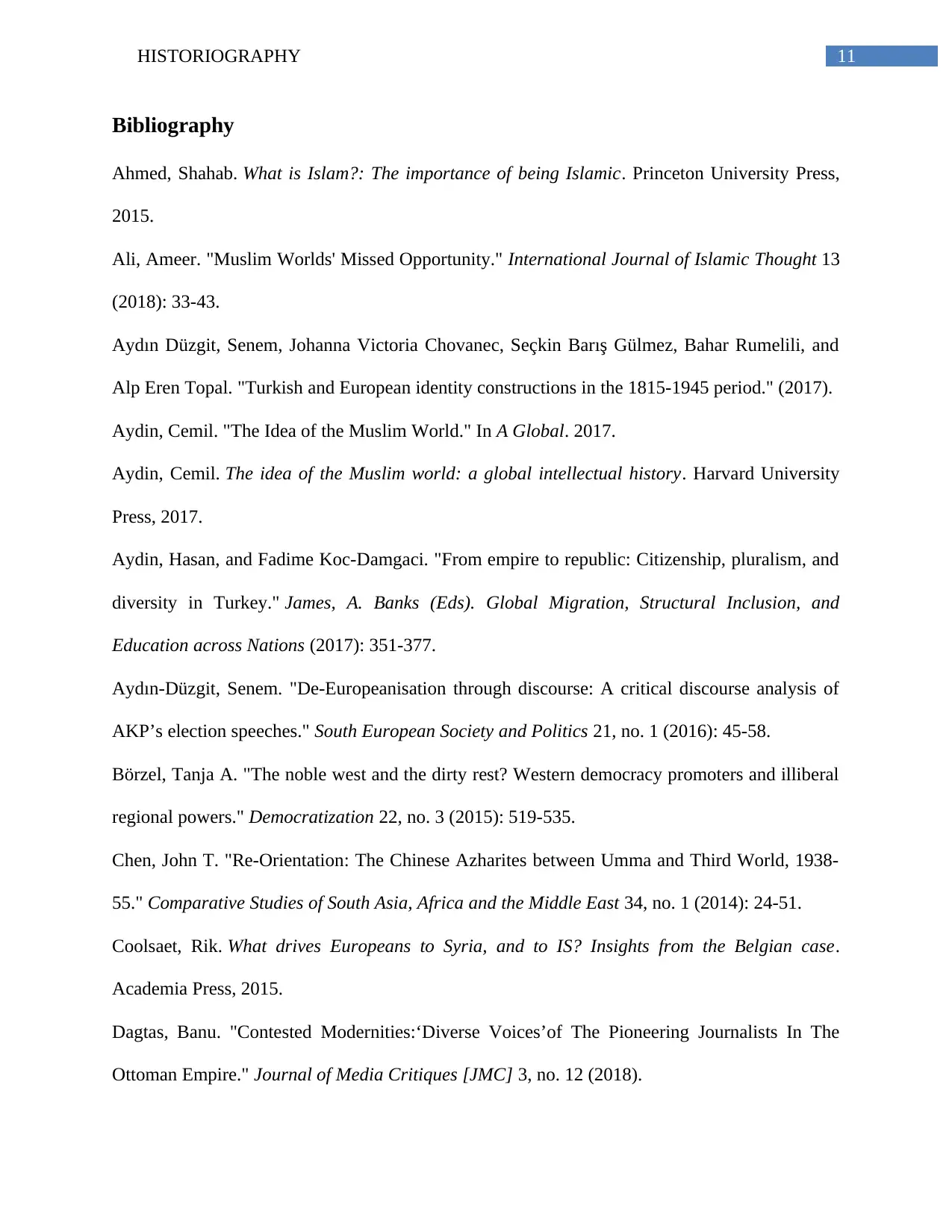
11HISTORIOGRAPHY
Bibliography
Ahmed, Shahab. What is Islam?: The importance of being Islamic. Princeton University Press,
2015.
Ali, Ameer. "Muslim Worlds' Missed Opportunity." International Journal of Islamic Thought 13
(2018): 33-43.
Aydın Düzgit, Senem, Johanna Victoria Chovanec, Seçkin Barış Gülmez, Bahar Rumelili, and
Alp Eren Topal. "Turkish and European identity constructions in the 1815-1945 period." (2017).
Aydin, Cemil. "The Idea of the Muslim World." In A Global. 2017.
Aydin, Cemil. The idea of the Muslim world: a global intellectual history. Harvard University
Press, 2017.
Aydin, Hasan, and Fadime Koc-Damgaci. "From empire to republic: Citizenship, pluralism, and
diversity in Turkey." James, A. Banks (Eds). Global Migration, Structural Inclusion, and
Education across Nations (2017): 351-377.
Aydın-Düzgit, Senem. "De-Europeanisation through discourse: A critical discourse analysis of
AKP’s election speeches." South European Society and Politics 21, no. 1 (2016): 45-58.
Börzel, Tanja A. "The noble west and the dirty rest? Western democracy promoters and illiberal
regional powers." Democratization 22, no. 3 (2015): 519-535.
Chen, John T. "Re-Orientation: The Chinese Azharites between Umma and Third World, 1938-
55." Comparative Studies of South Asia, Africa and the Middle East 34, no. 1 (2014): 24-51.
Coolsaet, Rik. What drives Europeans to Syria, and to IS? Insights from the Belgian case.
Academia Press, 2015.
Dagtas, Banu. "Contested Modernities:‘Diverse Voices’of The Pioneering Journalists In The
Ottoman Empire." Journal of Media Critiques [JMC] 3, no. 12 (2018).
Bibliography
Ahmed, Shahab. What is Islam?: The importance of being Islamic. Princeton University Press,
2015.
Ali, Ameer. "Muslim Worlds' Missed Opportunity." International Journal of Islamic Thought 13
(2018): 33-43.
Aydın Düzgit, Senem, Johanna Victoria Chovanec, Seçkin Barış Gülmez, Bahar Rumelili, and
Alp Eren Topal. "Turkish and European identity constructions in the 1815-1945 period." (2017).
Aydin, Cemil. "The Idea of the Muslim World." In A Global. 2017.
Aydin, Cemil. The idea of the Muslim world: a global intellectual history. Harvard University
Press, 2017.
Aydin, Hasan, and Fadime Koc-Damgaci. "From empire to republic: Citizenship, pluralism, and
diversity in Turkey." James, A. Banks (Eds). Global Migration, Structural Inclusion, and
Education across Nations (2017): 351-377.
Aydın-Düzgit, Senem. "De-Europeanisation through discourse: A critical discourse analysis of
AKP’s election speeches." South European Society and Politics 21, no. 1 (2016): 45-58.
Börzel, Tanja A. "The noble west and the dirty rest? Western democracy promoters and illiberal
regional powers." Democratization 22, no. 3 (2015): 519-535.
Chen, John T. "Re-Orientation: The Chinese Azharites between Umma and Third World, 1938-
55." Comparative Studies of South Asia, Africa and the Middle East 34, no. 1 (2014): 24-51.
Coolsaet, Rik. What drives Europeans to Syria, and to IS? Insights from the Belgian case.
Academia Press, 2015.
Dagtas, Banu. "Contested Modernities:‘Diverse Voices’of The Pioneering Journalists In The
Ottoman Empire." Journal of Media Critiques [JMC] 3, no. 12 (2018).
⊘ This is a preview!⊘
Do you want full access?
Subscribe today to unlock all pages.

Trusted by 1+ million students worldwide
1 out of 13
Related Documents
Your All-in-One AI-Powered Toolkit for Academic Success.
+13062052269
info@desklib.com
Available 24*7 on WhatsApp / Email
![[object Object]](/_next/static/media/star-bottom.7253800d.svg)
Unlock your academic potential
Copyright © 2020–2025 A2Z Services. All Rights Reserved. Developed and managed by ZUCOL.





